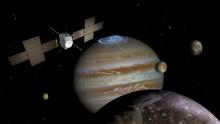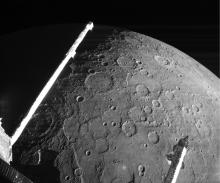Listen to today's episode of StarDate on the web the same day it airs in high-quality streaming audio without any extra ads or announcements. Choose a $8 one-month pass, or listen every day for a year for just $30.
You are here
JUICE II
[AUDIO: Ganymede radio]
That’s the “voice” of Ganymede, the largest moon of the planet Jupiter — radio waves recorded by a spacecraft in 1996. The waves tell us that the moon produces its own magnetic field — the only moon in the solar system that does so. And that helps us learn about Ganymede’s interior — including the likelihood that it has a hidden ocean.
Ganymede is the main target for JUICE, a European spacecraft scheduled to launch this month. It’ll enter orbit around Jupiter in 2031. It’ll make a couple of dozen close passes by Ganymede and Jupiter’s other big icy moons, Europa and Callisto. Then it’ll settle into orbit around Ganymede — the largest moon in the entire solar system.
Ganymede’s ocean appears to be about 60 miles deep, and it’s buried almost a hundred miles below the surface. It contains more water than all of Earth’s oceans combined.
Motions of the layers inside Ganymede generate the magnetic field, which was also “heard” by the Juno spacecraft a couple of years ago. Sloshing saltwater in the ocean may alter the field, causing a “wobble” in the moon’s auroras.
The ocean could have all of the basic ingredients for life: water, along with energy and minerals from volcanic “geysers” on the ocean floor. So it’s possible that Ganymede could host life. JUICE won’t tell us whether that’s the case. But it should provide new details about a giant ocean that’s hidden from view.
More tomorrow.
Script by Damond Benningfield





